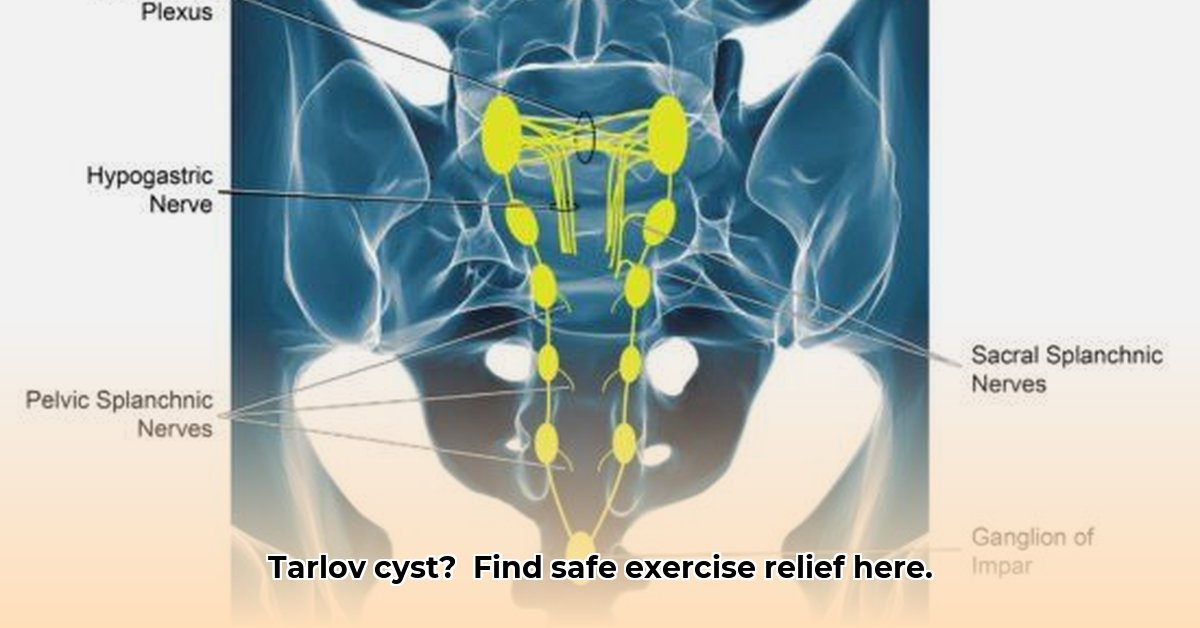“`markdown
Safe Exercises for Tarlov Cysts: Your Guide to Pain-Free Movement
Tarlov cysts can make everyday life trickier, especially when it comes to exercise. Knowing which moves to skip is key to managing pain and avoiding problems down the road. This guide will help you understand how to exercise safely with Tarlov cysts. We’ll cover what exercises to avoid, suggest better options, and help you create a plan that works for you. We’ll explain things clearly, without complicated medical terms, so you can feel confident taking control of your health and fitness. Let’s find the right balance of activity and rest to help you feel your best.
Exercises to Avoid with Tarlov Cysts: Protecting Your Spine and Improving Your Life
Living with Tarlov cysts can feel like walking a tightrope – you want to stay active, but you also need to protect your spine. This guide helps you understand which exercises to avoid to minimize pain and maximize your well-being. We’ll also explore safe movement options to keep you moving comfortably.
Understanding Tarlov Cysts and Why Exercise Matters
Tarlov cysts are fluid-filled sacs that develop near the nerve roots in your spinal column, most commonly in the sacral region (lower back). These cysts contain cerebrospinal fluid (CSF) and can vary in size. While many people with Tarlov cysts experience no symptoms, others may develop a range of issues depending on the cyst’s size, location, and impact on surrounding nerves. Symptoms can include pain (localized in the lower back, buttocks, or legs), numbness or tingling, and in some cases, bowel or bladder dysfunction.
Exercise is important for overall health, but certain activities can exacerbate symptoms. High-impact exercises or those that put excessive strain on the lower back may increase pressure on the cysts and surrounding nerves. Therefore, understanding which exercises to avoid is crucial for managing your condition effectively. Remember, we’re aiming for pain management and improved quality of life.
High-Impact Activities: A Big No-No
High-impact exercises are generally not recommended for people with Tarlov cysts. The jarring and repetitive motions can put excessive stress on the spine, potentially irritating the cysts and worsening symptoms. It’s best to avoid these activities completely:
- Running and Jogging: The repetitive pounding on your spine isn’t good for Tarlov cysts. The impact from each stride can increase pressure on the cysts and adjacent nerve roots.
- Jumping and Plyometrics: Any activity that involves significant impact – jumping jacks, box jumps, skipping rope, burpees – should be avoided. The sudden and forceful nature of these movements can strain the spine.
- High-Intensity Interval Training (HIIT): While effective for fitness, HIIT workouts often involve rapid, high-impact movements and intense bursts of activity that might not be suitable for individuals with Tarlov cysts.
- Contact Sports: Sports such as basketball, football, and soccer involve a higher risk of falls and collisions, which can put undue stress on the spine.
- Step Aerobics and High-Impact Dance Workouts: These classes put your lower back under considerable stress due to repetitive jumping and high-impact movements.
These are generally considered off-limits because the risk of a painful flare-up outweighs the benefits.
Movements That Strain Your Spine: Proceed with Caution
Certain movements place a lot of stress on your spine—stress that can directly affect the sacral nerves where Tarlov cysts often form. These exercises might feel okay initially, but they can lead to problems later. Be extra cautious with these:
- Heavy Weightlifting: Lifting heavy objects, especially with improper form or exercises that place significant strain on the lower back, puts immense pressure on your lower back. Deadlifts, squats with heavy weights, and overhead presses can all be problematic.
- Deep Forward Bends (Touching Your Toes): These stretches can irritate the nerves surrounding your Tarlov cysts. Overstretching the spine can potentially aggravate Tarlov cyst-related symptoms by putting pressure on the affected nerve roots.
- Traditional Sit-Ups and Crunches: The forceful crunching motion can put unnecessary strain on your spine. Modified sit-ups, emphasizing core engagement without extreme flexion, might be okay, but always listen to your body.
- Twisting Movements: Activities like golf swings, tennis, or certain yoga poses involving twisting can aggravate your condition. Twisting movements can strain the spine and may lead to increased pressure on the affected nerve roots.
- Prolonged Sitting or Standing: Maintaining the same posture for extended periods can put undue stress on the spine.
The rule here is simple: listen to your body. Even if something feels fine at first, stop immediately if you experience increased pain or discomfort. Gentle, controlled movements are far safer.
Gentle Movement: A Path to Relief and Wellbeing
While many exercises are best avoided, it doesn’t mean you must become sedentary. Gentle, low-impact activities can help maintain your fitness and well-being:
- Swimming: The water supports your body, allowing for a great cardiovascular workout without the jarring impact of land-based exercises. Swimming engages various muscle groups without stressing the spine.
- Walking: Brisk walking is beneficial, but keep it at a comfortable pace, mindfully engaging your core muscles for better spinal support. Walking on soft surfaces, like grass or a treadmill with cushioning, is a good option.
- Cycling (stationary or outdoor): This provides a good cardiovascular workout with minimal impact on your spine. Ensure your bike is properly fitted to avoid awkward posture.
- Elliptical Training: Using an elliptical machine allows for a smooth, gliding motion that mimics walking or running without the impact on joints and the spine.
- Modified Yoga and Pilates: Focus on gentle stretches and poses that don’t involve twisting or deep forward bends. A qualified yoga or Pilates instructor experienced with back conditions can be an invaluable asset. Cat-cow stretches, pelvic tilts, and gentle hamstring stretches can be beneficial.
Core Strengthening: Supporting Your Spine
Gentle core strengthening is often beneficial. A stronger core provides better spinal support, potentially reducing stress on the nerves affected by Tarlov cysts. But it’s crucial to choose exercises carefully and listen to your body. Avoid anything that increases your pain. Start slowly and gradually increase intensity.
- Pelvic Tilts: This exercise engages the core and buttocks muscles without involving excessive strain on the lower back.
- Bridges: Bridges help strengthen the core muscles, which can provide support to the spine.
- Plank Variations: Modified planks or planks performed with proper form can strengthen the core without exacerbating discomfort.
- Bird Dog: This exercise helps to improve core stability and balance.
Pilates-based exercises might be particularly well-suited to strengthening core muscles gently. Others suggest focusing on strengthening the muscles surrounding the pelvis to provide indirect support. The best approach likely involves personalized guidance from a physical therapist.
Creating Your Personalized Exercise Plan
This guide provides general advice, but your specific situation is unique. It’s vital to consult your doctor or a physical therapist before starting any exercise program. They can assess your condition, understand your fitness goals, and create a personalized plan that’s both safe and effective. They’ll help you navigate which exercises to avoid and which activities are appropriate for your individual needs. A physical therapist can design a personalized exercise program that addresses your specific needs and limitations. Regular monitoring and adjustments to the routine are important for optimal results.
Remember, gradual progress is key. It’s better to build a sustainable exercise routine slowly than to try too much too soon and risk a setback.
Additional Tips for Safe Exercise
- Listen to Your Body: Pay attention to any signals from your body during and after exercise. Symptoms like increased pain, numbness, or tingling should not be ignored.
- Warm-Up Properly: Before starting any exercise, make sure to warm up your muscles with gentle stretches and light cardio.
- Cool Down: After exercising, take some time to cool down and stretch your muscles.
- Maintain Good Posture: Proper posture is essential for supporting the spine and reducing stress on the nerves.
- Stay Hydrated: Drink plenty of water before, during, and after exercise.
- Take Breaks: If you feel pain or discomfort, stop exercising and rest.
- Consider Assistive Devices: Using walking sticks or braces can provide additional support and stability.
Risk Assessment: A Quick Guide
| Exercise Type | Risk Level | Potential Consequences | Mitigation Strategies |
|---|---|---|---|
| Low-impact cardio (swimming, walking, cycling) | Low | Minimal risk; may improve cardiovascular health, strength, and mobility. | Maintain a comfortable pace; stop if any pain occurs. |
| Gentle core strengthening | Low to Medium | Minor muscle strain possible; minimal risk if done right. | Focus on proper form; start slowly; listen to your body; consult with a physical therapist. |
| High-impact activities (running, jumping) | High | Significant increase in pain and nerve irritation likely. | Avoid completely. |
| Heavy Lifting | High | Increased spinal pressure, worsening symptoms likely. | Avoid completely or use very light weights with proper form and guidance. |
| Twisting/Bending (Extreme) | Medium to High | Nerve irritation probable. |
- Achieve Anesthesiology Work-Life Balance: Your Guide - December 4, 2025
- Unlock Young Doctors’ Work-Life Balance: Actionable Strategies Now - December 2, 2025
- Unlock Life Harmony: Work-Life Integration Guide - November 30, 2025











